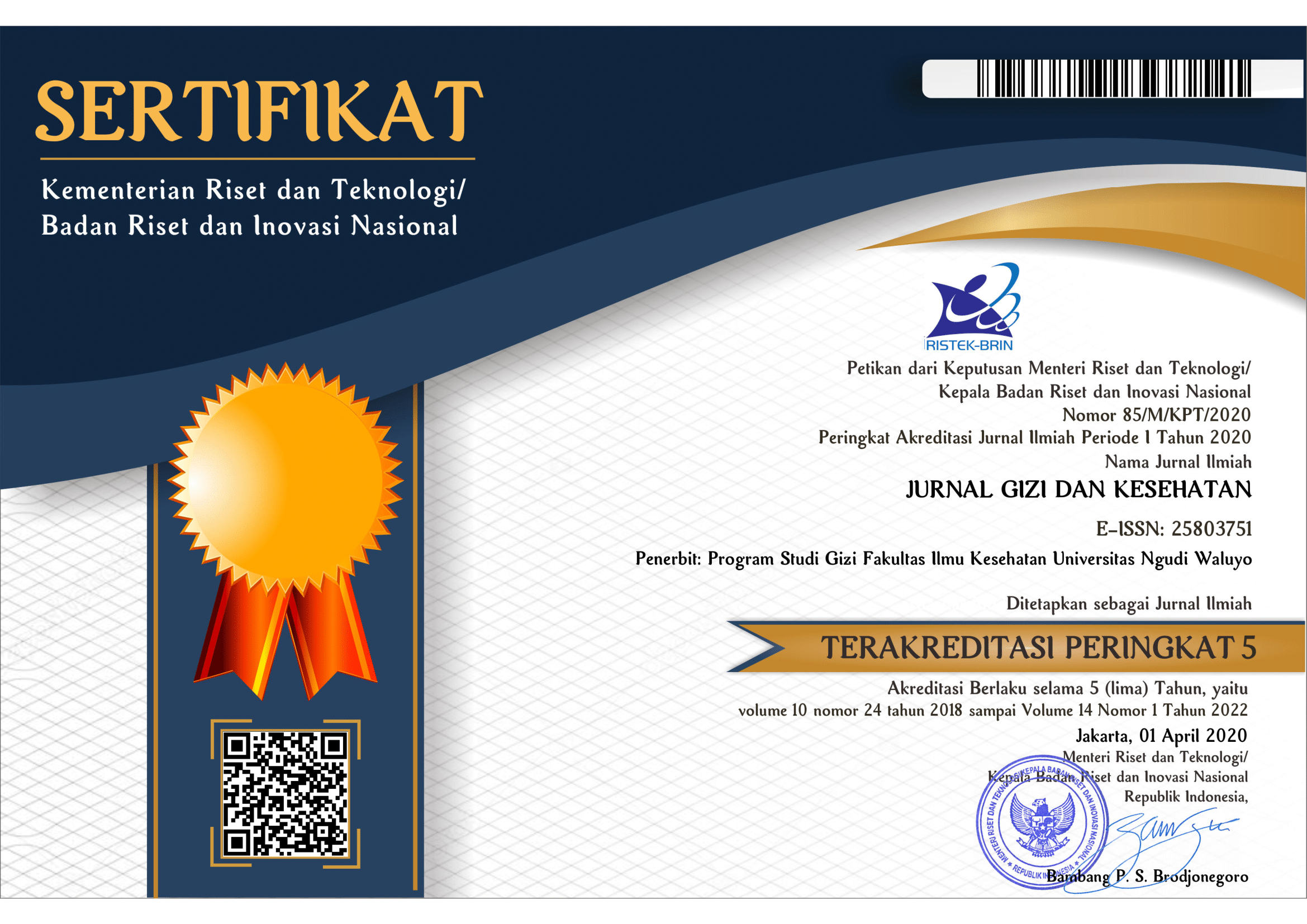Hubungan Pola Konsumsi Gaya Hidup dan Lingkungan dengan Obesitas pada Polisi (Studi di Kepolisian Resor Kabupaten Tanah Laut)
Relationship Between Consumption Pattern Lifestyle and Environment with Police Obesity (Study at Tanah Laut District Resort Police)
DOI:
https://doi.org/10.35473/jgk.v16i1.482Keywords:
Pola Konsumsi, Gaya Hidup, Lingkungan, Obesitas Pada PolisiAbstract
Indonesia currently has three burdens of nutritional problems which are often called the triple burden, namely stunting, wasting, and obesity as well as macronutrient deficiencies such as anemia. Although police officers in their early careers are thought to be more physically active than the general population, studies show that police officers are more prone to obesity. The purpose of this study was to determine the relationship between consumption patterns, lifestyle, and environment with obesity among police officers at the Tanah Laut District Police. This type of research is analytic observational with a cross-sectional design. The population of this study were all police officers in the Tanah Laut District Police. Determination of the sample with a total sampling technique of 40 people. Analysis of the test data used is Spearman's rank test.Based on the results of the Spearman rank test, there is no relationship between energy intake (ρ: 0.418), carbohydrates (ρ: 0.453), fat (ρ: 0.148), protein (ρ: 0.410) and obesity. Lifestyle variable (ρ: 0.083) showed no relationship with obesity in the police. Finally, the environmental variable (ρ: 0.126) shows that there is no relationship between the environment and obesity among police officers. It is suggested that the Tanah Laut District Police can carry out early detection and create a light exercise training program for police officers who are entering their late adulthood so that they can reduce obesity and for obese police they can pay more attention to consumption patterns that can cause obesity and can increase physical activity so that can reduce accumulated fat.
ABSTRAK
Indonesia saat ini mempunyai tiga beban masalah gizi yang sering disebut triple burden yaitu stunting, wasting, dan obesitas serta kekurangan zat gizi makro seperti anemia. Meskipun polisi di awal karir mereka dianggap lebih aktif secara fisik daripada populasi umum, studi menunjukkan bahwa polisi lebih rentan obesitas. Tujuan penelitian ini adalah untuk Mengetahui hubungan antara pola konsumsi, gaya hidup, dan lingkungan dengan obesitas pada polisi di Kepolisian Resor Kabupaten Tanah Laut. Jenis penelitian ini adalah observasional analitik dengan desain yang bersifat cross sectional. Populasi penelitian ini adalah seluruh anggota polisi di Kepolisian Resor Kabupaten Tanah Laut. Penentuan sampel dengan teknik total sampling sebanyak 40 orang. Analisis data uji yang digunakan adalah uji rank spearman.Berdasarkan hasil uji rank spearman tidak ada hubungan antara asupan energi (ρ: 0,418), karbohidrat (ρ: 0,453), lemak (ρ: 0,148), protein (ρ: 0,410) dengan obesitas. Variabel gaya hidup (ρ: 0,083) menunjukkan tidak ada hubungan dengan obesitas pada polisi. Terakhir pada variabel lingkungan (ρ: 0,126) menunjukkan tidak ada hubungan lingkungan dengan obesitas pada polisi. Disarankan untuk Kepolisian Resor Kabupaten Tanah Laut bisa melakukan deteksi dini serta membuat program latihan olahraga ringan untuk anggota polisi yang sudah memasuki usia dewasa akhir agar dapat mengurangi obesitas dan untuk polisi yang obesitas bisa lebih memperhatikan pola konsumsi yang dapat menyebabkan obesitas serta dapat meningkatkan aktivitas fisik agar dapat mengurangi lemak yang menumpuk.
Downloads
References
Kemenkes, 2020. Faktor Penyebab Obesitas http://p2ptm.kemkes.go.id/informasi-p2ptm/obesitas [Diakses 19 Juli 2022 jam 12.00 WITA]
Litbangkes., 2018. Laporan Nasional Riskesdas 2018 https://labmandat.litbang.kemkes.go.id/menu-progress-puldata/progress-puldata-rkd-2018 [Diakses 19 Juli 2022 jam 12.00 WITA]
Kemenkes, 2020. Faktor Penyebab Obesitas http://p2ptm.kemkes.go.id/informasi-p2ptm/obesitas [Diakses 19 Juli 2022 jam 12.00 WITA]
Sindermann C, Kendrick KM, Becker B, Li M, Li S, Montag C, 2017. Does growing up in urban compared to rural areas shape primary emotional traits?. Behavioral sciences (Basel, Switzerland), 7(3):60.
Geiker NRW, Astrup A, Hjorth MF, 2018. Does stress influence sleep patterns, food intake, weight gain, abdominal obesity and weight loss interventions and vice versa?. Obesity Reviews, 19:81– 97.
Pradeepa, R. et al, 2015. prevalence of generalized & abdominal obesity in urban & rural - the ICMR-INDIAB Study (Phase-I) [ICMR-INDIAB-3] Rajendra. Indian J Med Res 142, 139–150.
Kemenkes, 2019. Tabel Batas Ambang Indeks Masa Tubuh (IMT) http://p2ptm.kemkes.go.id/infographicp2ptm/obesitas/tabel-batas-ambang-indeks-massa-tubuh-imt [Diakses 19 Juli 2022 jam 12.00 WITA]
Sudikno, H.S., Dwiriani, C.M., Riyadi, H. and Negara, J.P., 2015. Faktor risiko obesitas sentral pada orang dewasa umur 25-65 tahun di Indonesia (analisis data riset kesehatan dasar 2013)(risk factors central obesity in 25-65 year-old Indonesian adults [analysis data of basic health research 2013]). Penelit Gizi dan Makanan, 38(2), pp.111-20.
Yulia, Khusun, H. & Fahmida, U, 2016. Dietary patterns of obese and normal-weight women of reproductive age in urban slum areas in Central Jakarta. British Journal of Nutrition 116, S49–S56.
Sartorius B, Sartorius K, Aldous C, Madiba TE, Stefan C, Noakes T. 2017. Carbohydrate intake, obesity, metabolic syndrome and cancer risk? A twopart systematic review and metaanalysis protocol to estimate attributability. BMJ Open. 6 :e009301.
Purwaningrum, D. N., Hasanbasri, M. & Trisnantoro, L. Obesity and the poor women living in urban slum areas : health system response. BMC Public Health 12, 2458 (2012)
Turege, J.N., Kinasih, A. and Kurniasari, M.D., 2019. Hubungan Antara Aktivitas Fisik Dengan Obesitas Di Puskesmas Tegalrejo, Kota Salatiga. Jurnal Ilmu Keperawatan Dan Kebidanan, 10(1), pp.256-263.
WHO. (2017) World Health Organization : Global Strategy on Diet, Physical Activity and Health.
Rachmi C.N., Li M., and Baur A. (2017). Overweight and obesity in Indonesia: prevalence and risk factors—a literature review. Public Health, Elsevier. 147:20-29. [https:// doi: 10.1016/j.puhe.2017.02.002]
Rani, J.K., Syainah, E. and Mas' odah, S., 2021. Hubungan Aktifitas Fisik, Asupan Lemak dan Karbohidrat terhadap Status Gizi Mahasiswa Gizi Poltekkes Banjarmasin. Jurnal Riset Pangan dan Gizi, pp.17-25.
Poudel, P. (2018). Junk Food Consumption and Its Association with Body Mass Index Among School Adolescents. International Journal of Nutrition and Food Sciences, 7(3), 90.
Widyastuti, D. A. 2018. Pengaruh Kebiasaan Konsumsi Junk Food Terhadap Kejadian Obesitas Remaja. https://doi.org/10.31219/osf.io/7 d8ey
Pakaya, R., Badu, F. D., & Maliki, L. I, 2020. Hubungan aktivitas fisik dan pola konsumsi terhadap insiden obesitas sentral. Jurnal Olahraga dan Kesehatan Indonesia (JOKI), 1(1), 68-74.
Wahyuningsih, R. and Pratiwi, I.G., 2019. Hubungan aktifitas fisik dengan kejadian kegemukan pada remaja di Jurusan Gizi Politeknik Kesehatan Mataram. AcTion: Aceh Nutrition Journal, 4(2), pp.163-167.
Oates, G. R., Phillips, J. M., Bateman, L. B., Baskin, M. L., Fouad, M. N., & Scarinci, I. C, 2018. Determinants of obesity in two urban communities: Perceptions and community-driven solutions. Ethnicity & disease, 28(1), 33–42.
Interactive website: County Health Rankings and Roadmaps: Building a Culture of Health, County by County: United States>Alabama>Jefferson. Robert Wood Johnson Foundation. Last accessed December 18, 2017 from
http://www.countyhealthrankings.org/#app/alabama/2012/jefferson/ county/1/overall.









